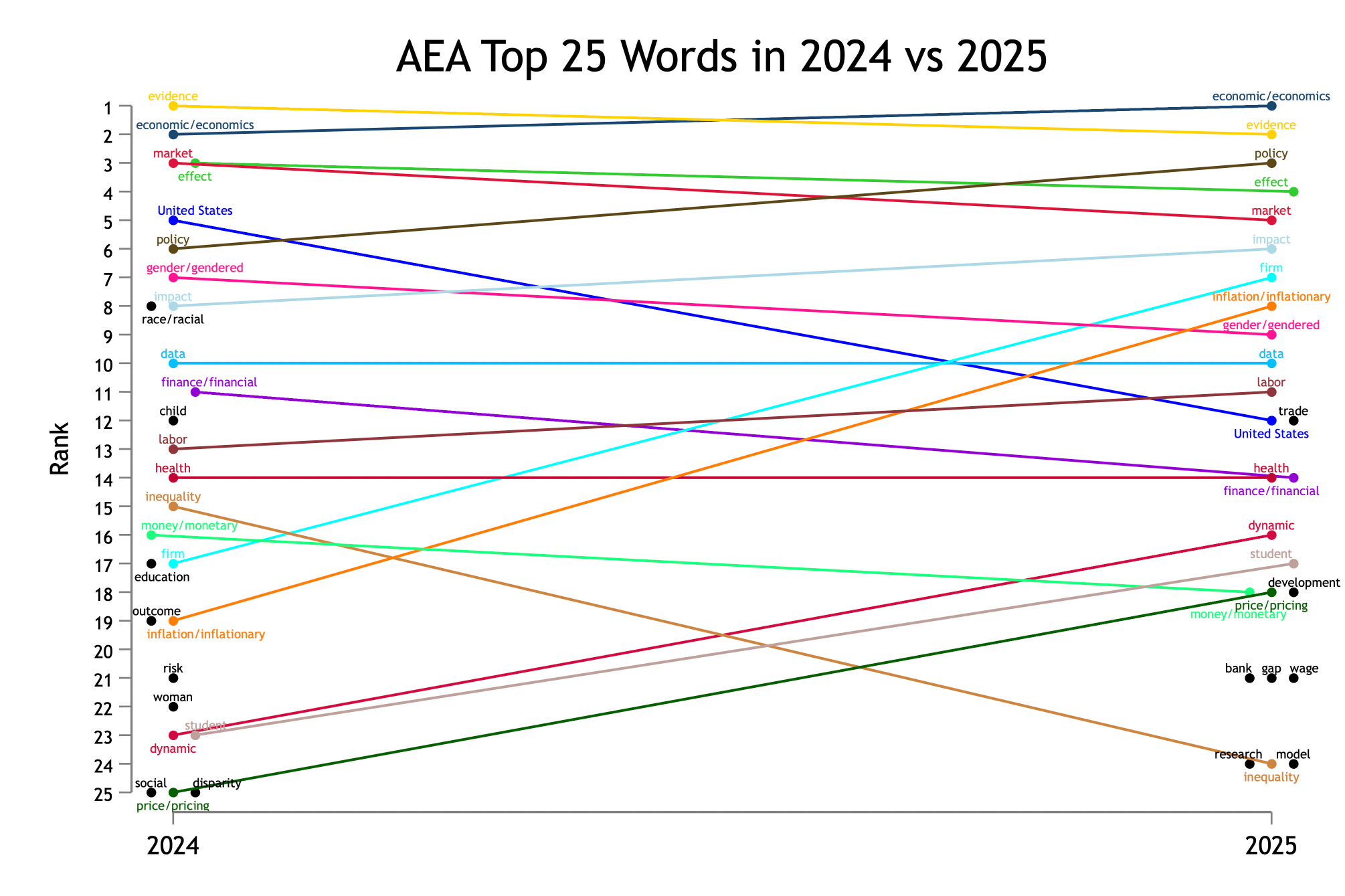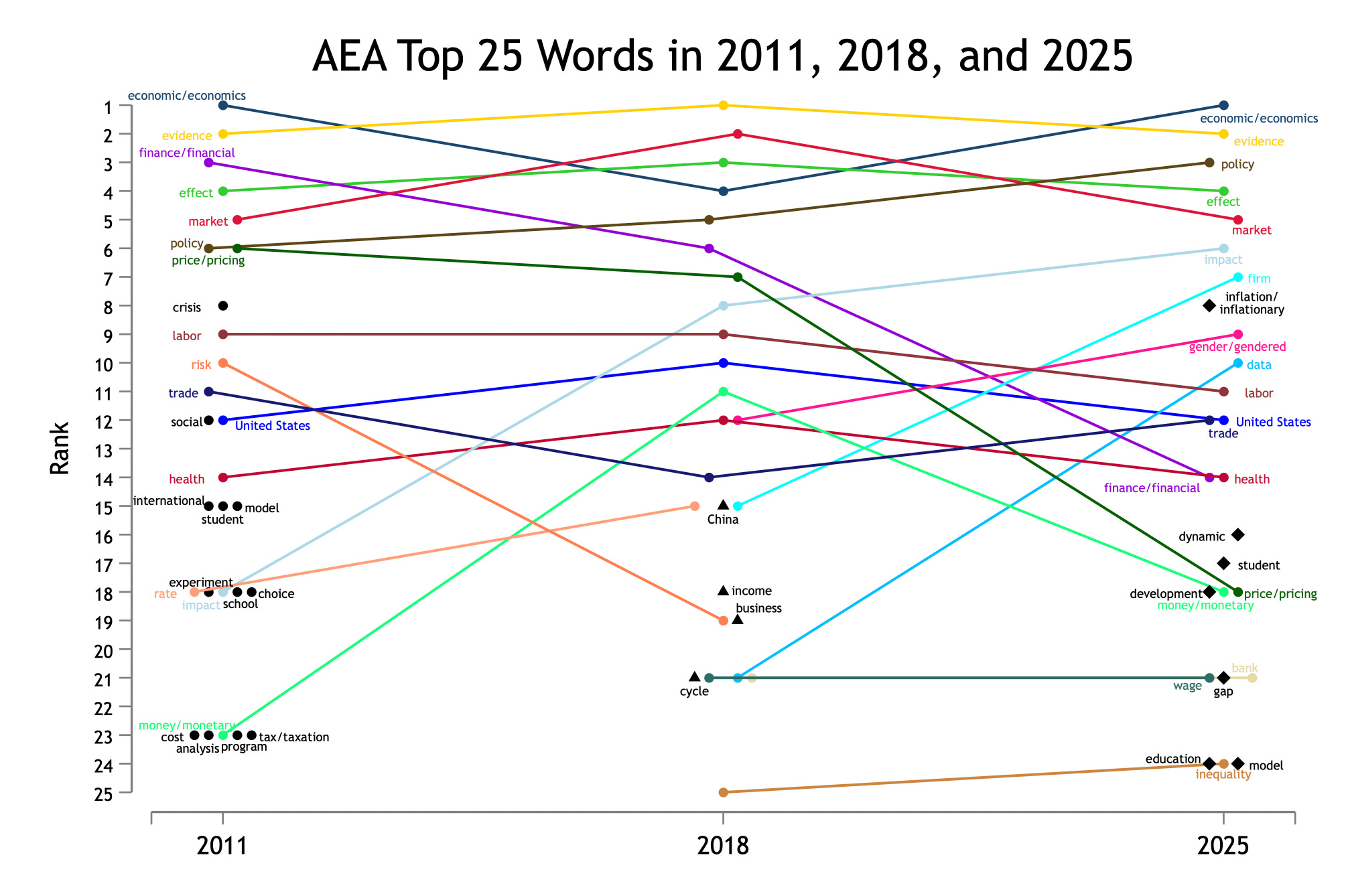A Word Count Analysis of AEA and AFA Programs: 2025 Update
Inflation and gender among top topic words. AI arrives on the scene. The "d-words" debt and deficits almost nowhere to be seen.
Earlier this month, the Allied Social Science Association (ASSA) held its annual meeting in San Francisco. This year’s meeting had over 5,700 registrants, a far cry from the pre-COVID days when attendance used to top 13,000. Among the two most notable associations present were American Economics Association (AEA), on which the ASSA is anchored, and the American Finance Association (AFA).
Around the time of last year’s conference, we conducted a word count analysis of the session names and paper titles in the sessions hosted by the AEA and AFA. This analysis aimed to identify and examine emerging trends in research interests among academics within each respective field. Our process involved scraping data from the conference’s webpage, tokenizing the text into individual words, lemmatizing these words to their base forms, and then using a script to count the frequency of each word. Using this approach, we determined the most common words for the AEA and AFA conference session names and paper titles from 2011 to 2024.
Employing this same methodology, this year we updated our word count ranks with data from the 2025 AEA and AFA conferences. The top 50 words for the AEA conference, and their frequency, can be seen below:
Economic/economics, evidence, policy, effect, and market—all mainstays of the top of the list—take up ranks one through five. More interesting, however, is what comes right below, as well as the entries that weren't present in 2024 but were in 2025 (and vice versa). AI cracks the top 50 (placing 29th overall) and technology returns for the first time since 2017. Race/racial, which was the 8th most common word in 2024, and disparity, which ranked #25, didn't make it into the top 50 at all in 2025. This marks the first time race/racial was not in the top 50 since 2021.
The graph above charts the movement of the top 25 words in 2024 and 2025. Looking at this chart reveals that inequality fell in representation. With its rank falling from #15 to #24, it sees the biggest decline of any word in the top 25. Inflation, on the other hand, sees a substantial rise. Here at least, it seems that economists who put the program together have their finger on the pulse of the people. Last year, 62% of Americans identified inflation as a “very big problem,” a higher percentage than those who expressed the same concern about illegal immigration, healthcare affordability, climate change, or racism.
While race/racial fell out of the top 25 (and top 50) in 2025, gender/gendered remain roughly constant, falling from rank #7 to rank #9, being newly surpassed by inflation and firm. Examining the graph above, which charts the changes in the AEA’s top 25 words in 2011, 2018, and 2025, we can see that the level of interest in gender is still up from where it was ranked in 2018.
A similar analysis of the American Finance Association (AFA) reveals significantly less variation compared to the AEA. The AFA’s top 50 words, as shown below, primarily consist of finance-related terms, reflecting a more focused scope than the broader range of topics observed by the AEA:
Graphing the shift in the AFA’s top 25 words from 2024 to 2025 underscores this consistency.
The most notable change between 2024 and 2025 is the addition of “climate” in 2025’s top 25, and “carbon” in its top 50. This potential shift in interest towards environmental finance is somewhat counteracted by ESG’s fall from the top 50, however, perhaps reflecting that ESG was already falling from grace in early 2024. (We note that these programs are assembled months ahead of the actual conference.)
The overall findings here are consistent with what we found last year. The AFA continues to focus on core topics in finance, as expected. On the AEA side, last time around we found a clear shift in interest towards research on gender and racial disparities. This year, gender remained popular but race and disparity fell from the top 50.
Once again we recall the oft-cited quote attributed to Jacob Viner: “Economics is what economists do.” What can we say about the newly hot topics in today’s research? AI is brand new. Gender has shown a dramatic increase over the past decade. Inflation is a classic topic that fell somewhat dormant for a time but was revived as a topic of interest with the global resurgence of inflation in the post-pandemic years.
Only time will tell what topics of interest will persist, rise, and fall. We bet on trade, already #12, breaking the top 10 in the 2026 meetings.
We conclude with a plea to next year’s organizers for Janaury 2026 in Philadelphia (brr). With interest payments on the US federal debt now surpassing military expenditures and topping 20% of federal revenue, the topic of debt and deficits is due for a return. Those “d words” didn’t even make the top 50 this year in the AEA. The AFA had “debt” squeaking into the top 25, though much of this appears to be of the corporate and private variety. We hope to see more of the “d words” on the program next year, lest a sovereign debt crisis occur and the associations appear out of touch. Think of it at least as a hedge.
Appendix: Methodology
To conduct this analysis, we started by collecting data from the American Social Science Association’s (ASSA) annual meeting programs. We took the session names and paper titles for sessions affiliated with either the American Economic Association (AEA) or American Finance Association (AFA), from each year’s program from 2011 to 2025. Our analysis begins in 2011 as this was the first year the ASSA program website includes an html page that notes which association hosted each session, although in theory it is possible to go back further in time by scraping pdf versions of the program.
To scrape this data, we used a Python script which identified whether a session was hosted by either the AEA or AFA, and, if so, collected the name of the session and its respective papers, creating two raw data files, one for each association. If a session was jointly hosted by the AEA or AFA and additional organization, its associated data was included in the raw files. As the webpages for the programs differ in format over the years, three different scripts were used to scrape this data: one for the years 2011 to 2016, one for 2017 to 2020, and one for 2021 to 2025.
After collecting the raw data, the files were run through a script that removed duplicate session names and paper titles to ensure each one was only counted once. We then consolidated certain similar words together and accounted for some common two-word named entities. Noun-adjective pairs such as gender and gendered, inflation and inflationary, money and monetary, race and racial, and taxation and tax were mapped together. Similarly, the various forms of the word “United States” (such as US, U.S., USA) were all consolidated to one version as well. Common two-word cities, such as New York, San Francisco, and San Diego, were treated as one word. We then put all words in their lowercase form, and excluded common stop words (“and”, “but”, “is”, “a”, “do”, “I”, etc.) and non-alphanumeric entities.
To handle the more general inflected variants of words, we converted the tokenized entities to their base form using NLTK’s lemmatizer. NLTK is a platform providing interfaces for the building of Python programs to work with human language data. These word base forms (or “lemmas”) were then counted using the Python Collections module’s “counter”. The top 50 words for each year were then taken from this output.







